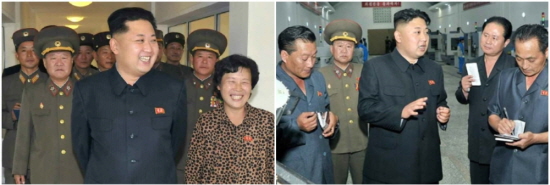 Choe Ryong Hae stares into the camera in the two images, which were published by Rodong Sinmun in recent days. (Image: Rodong Sinmun) |
In recent days, the official daily publication of the Chosun Workers’ Party,
Rodong Sinmun has been publishing articles predicting the coming
heyday of North Korea. These have been accompanied by images of Kim Jong Eun
performing onsite inspections in various locations. However, it is Choe Ryong Hae who stands out in the images, not Kim.
On January 5th, Rodong Sinmun released an image of Kim visiting
a machine factory in July 2013, and on the 6th a further image
of Kim at the Central Mushroom Research Institute was published.
Within the structure of North Korean propaganda methodology, “no.1
images” such as these are arranged to emphasize the leading role and wisdom of
the supreme leader, in this case Kim Jong Eun. Kim should be in the center of
the image, and other officials and personnel present in the frame should observe him or his
actions. However, in the two images cited, Choe is visible in the background
staring straight into the camera.
In such a context, Choe’s actions, and the decision to publish the photos, is both abnormal and inappropriate.
Images of the leader are managed and overseen by the
Propaganda and Agitation Department of the Workers’ Party, and should only be authorized for publication once the background, leader’s expression and
accompanying personnel have all been audited to ensure consistency of message.
Therefore, either the images were deliberately released to emphasize the role
of Choe and the military that he represents as director of the KPA General
Political Bureau, or the action was not deliberate and the officials who
erroneously permitted the images to be published could face censure.
A senior defector told Daily NK today that the second outcome is by no means unheard of. “In North Korea, many, many no.1 images are put through an auditing
process and then published, but sometimes mistakes are made and the person in
charge gets punished for it,” he said. “This time the same could have happened, and the person in
charge could find themselves facing criticism.”

















